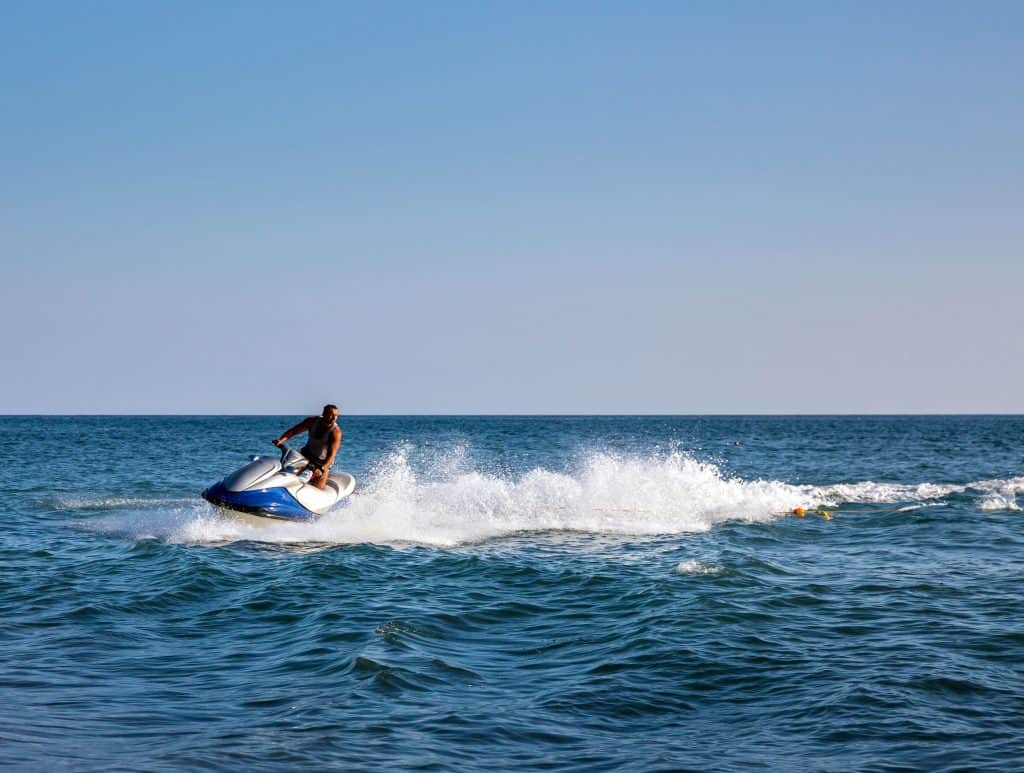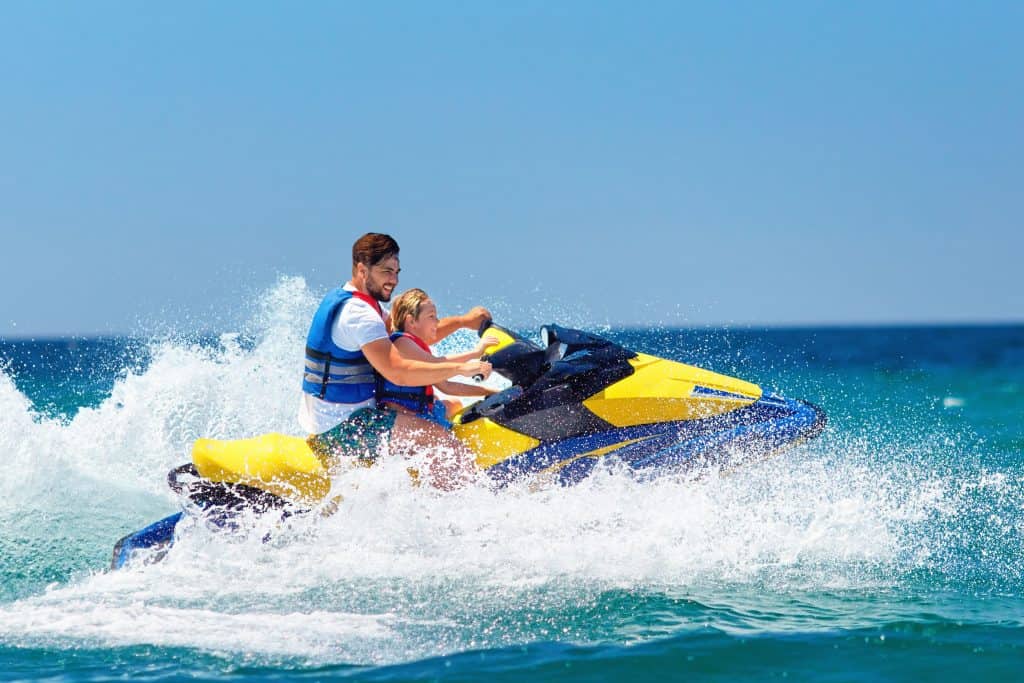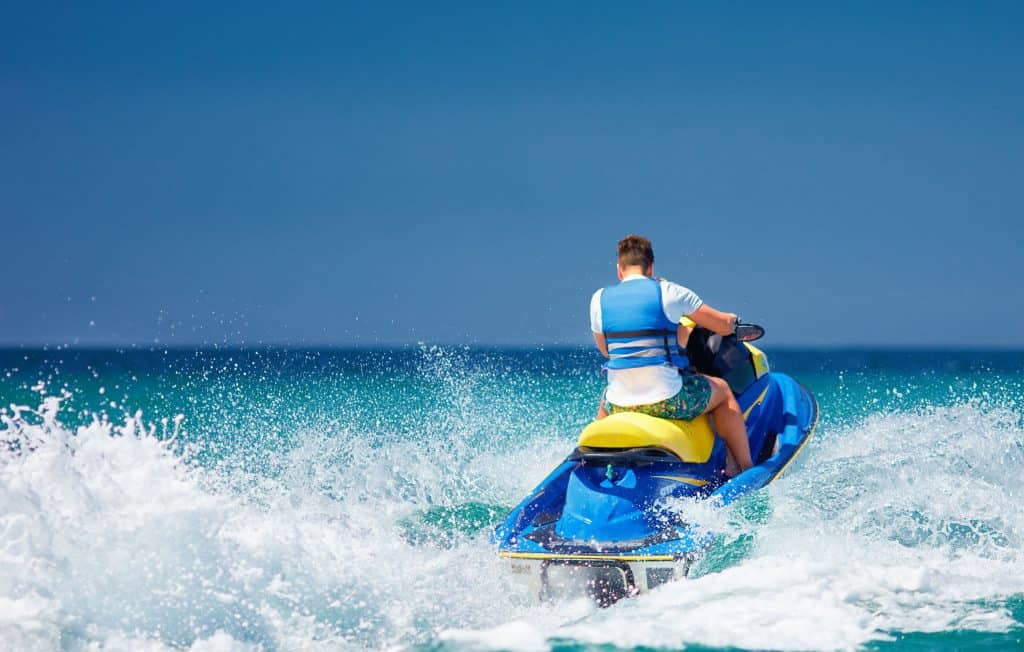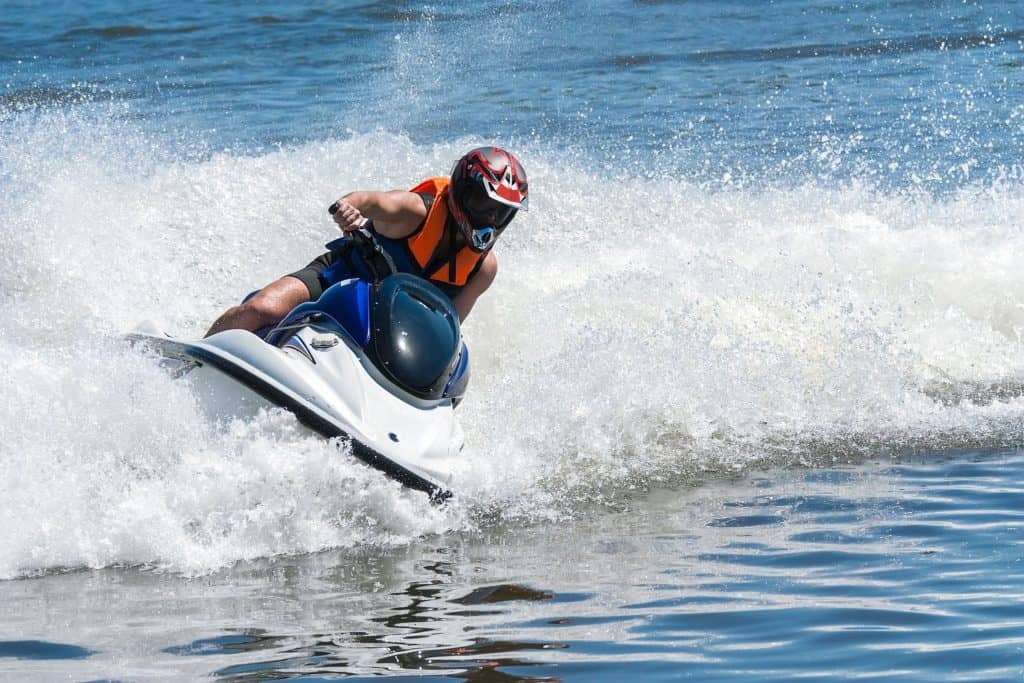Jet skiing can be a pretty enjoyable, and fulfilling activity to participate in during the summertime! It can be an amazing way to create some memories with family and friends. Though to ensure you can have some uninterrupted fun you will need to know the laws that apply to jet skis within the state you are in.
To operate a PWC in the state of Hawaii, you must be at least 15 years of age and you must also complete a boating education course. Once you complete the course you will receive a certificate of completion. You must bring that on board with you as well as a boating license.

The Basics
Hawaii Registration Fees
| Initial Registration | |
| Shorter than 20 feet | $13.00 |
| 20 feet and longer | $30.00 |
| Renewal Fees | |
| Shorter than 20 feet | $10.00 |
| 20 feet and longer | $15.00 |
| Amphibious Vehicle | |
| Initial Registration | $15.00 |
| Renewal Fee | $10.00 |
Hull Identification Number
A Hull Identification Number (HIN) is a 12-digit number that is assigned by the manufacturer to vessels built after 1972. They help be able to determine the difference between multiple watercraft vehicles.
In case your vessel is stolen you should write down your HIN number and put it somewhere safe.
Numbers and Stickers
Once you receive your registration number and the validation stickers you must display these items in the following ways:
- Each number has to be painted and applied onto your vessel as a decal. Or you can place it to be shown on both sides of the bow.
- The numbers must be read from left to right on both sides.
- Each number must be in block letters and three-inches high.
- The color of your numbers must also be in contrast with the background of your vessel.
- The letters have to be separated from the numbers space or a hyphen.
- There also cannot be any other numbers shown on the bow of your vessel.
Unlawful Operation of a PWC or Vessel
Hazardous Condition
This is when you knowingly allow another person to use a PWC when they suffer from any conditions that may prevent them from operating it to the best of their ability. Conditions that can be hard for the operator and their passengers are:
- If the operator has a physical or mental disability
- If there are not enough personal flotation devices, fire extinguishers, backfire flame arrestors, or navigational lights
- Or if an unsafe condition simply exists
Improper Speed or Distance
Failing to go at a reasonable speed and even going faster than the speed recommended, especially during vessel traffic, poor weather conditions and closeness to shore can result in injuries.
To be more specific, here are some actions that are considered to be illegal in the state of Hawaii:
- Going at a speed that can be harmful to your vessel
- Operating your PWC within 20 feet of another person who is fishing (gaining their permission first)
- Roaming around a swimming area (within 20 feet) and it is marked with red and yellow buoys.
- Going faster than the speed limit posted near the body of water you are operating on.
- Being within 20 feet of the outer boundary area that is marked by signs and buoys of it being a restricted area.
- Operating at a greater speed than “slow, no wake” speed that is posted in a “no wake” zone.
- Operating your vessel at extreme speeds in the close vicinity of another vessel, PWCs or dangerous waters.
Overloading or Overpowering
Going against the recommended weight and horsepower shown on your PWC or vessel is unsafe. You should never exceed the maximum number of persons or weight that is recommended when you purchase or operate a PWC.
If the PWC does not have a plate, in which it shows its capacity, the owner must be able to demonstrate that the PWC follows the safe loading and powering requirements given by the U.S. Coast Guard.
Reckless Operation
Recklessly operating and being negligent of the rules for operating a vessel or PWC is putting yourself and others in danger. The following are examples of negligent and reckless operations of a PWC or vessel:
- Anyone who is on a PWC or vessel that is fishing, water skiing, or engaging in water activity.
- Anyone who is swimming nearby.
- Unsafely approaching or passing a dock, ramp, a moored or anchored or even a swimming area that is marked illegal.
- Any other PWC or vessel.

Visual Distress Signals (VDS)
Visual distress signals are used for when a vessel or PWC operators need to signal for help in the eve of an emergency on the water.
Vessels operating on federally controlled waters must be equipped with visual distress signals that are approved by the U.S. Coast Guard. A list of approved VDS can be found in the chart below.
| Pyrotechnic Visual Distress Signals | Non-Pyrotechnic Visual Distress Signals | ||
| Orange Smoke | Day Signal | Electrical Light | Night Signal |
| Red Meteor | Day and Night Signal | Orange Flag | Day Signal |
| Red Flare | Day and Night Signal |
A minimum of three visual distress signals must be carried on your vessel or PWC.
It is also important to note that it is not advised nor encouraged to use these visual distress signals on the water if you do not need assistance or if you are not in immediate or potential danger.
Sound Producing Devices
Changing Direction
- one short blast: this is telling other vessel or boat operators that you have the intention of passing them on your port “left” side. “I intend to pass you on my port (left) side.”
- two short blasts: this is telling other vessel or boat operators that you are intending on passing them on your right side. “I intend to pass you on my starboard (right) side.”
- three short blasts: you are telling other operators that you are passing them. “I am backing up.”
Restricted Visibility
- one prolonged blast: this is a signal that tells others there is a power-driven vessel underway
- one prolonged blast plus two short blasts: if used in intervals for no more than two minutes that it is signal for sailing vessels
Warning
- one prolonged blast: this is a warning signal for coming up around a bend or exiting a slip
- five short, rapid blasts: this is to signal danger
Pyrotechnic Devices
While these visual distress signals are extremely effective they can also cause harm if not handled correctly.
these devices produce a hot flame and residue that can cause burns and even ignite flammable material.
Parachute flares and other pistol-like devices have many characteristics like a firearm and must be treated with caution (in some states they are considered firearms).
These types of devices should be stored in a cool, dry and easily accessible place.
Non-Pyrotechnic Devices
This type of visual distress signal needs to be readily accessible and in serviceable condition.
A distress flag is a day signal only. It typically needs to be 3 x 3 feet with a black square and ball on an orange background.
The electric light is designed to be used during the night and it must also be able to automatically flash an SOS signal, that way those around you or near you will be able to know you are in need of help.
Arm Signal
This is a day signal and its action is to summon help if you do not have any other visual distress signals on board your PWC or vessel.
It is important to keep several visual distress signals in order to avoid a situation where you must resort to an arm signal.

Required Equipment
Personal Flotation Devices
| TYPE 1 | TYPE 2 | TYPE 3 | TYPE 4 | TYPE 5 |
| Offshore Life Jackets | Near-Shore Vests | Flotation Aids | Throwable Devices | Special-Use Devices |
| This vest can turn an unconscious person in the water to face up in the water. It was made for rough waters and for situations where rescue might take a long time. | This vest is fit for calmer waters and faster rescues. If you were to wear this while unconscious it may not be able to turn you face up in the water. | This vest can also be full-sleeved jacket and it is great for calm waters and fast rescues. This will definitely not turn your face up in the rough waters. This is generally worn for water sports. | This type of flotation device is a cushion or ring buoys and are typically used to throw at someone in trouble. They are not made to last for long hours in the waters, or non-swimmers, or the unconscious. | This type of flotation device was made for activities like kayaking, water skiing. These typically look like water vests, deck suits and personal flotation device hybrids. |
Personal Flotation Device Requirements
- Any person that is on board a PWC or vessel (no matter the age) must wear a personal flotation device.
- Vessels have to have 1 of the 5 personal flotation devices on board your vessel and they also must be a wearable size for any passenger or operator.
- A Type 4 personal flotation device that is approved by the U.S. Coast Guard, and it must be on board a vessel that is 16 feet or longer and it must also be easily accessible for emergency use.
Navigational Lights
| Power-Driven Vessels when Underway |
The lights required on a vessel like this one are:
- Red and green sidelights that can be visible from at least 2-miles away, and at least a mile away on a clear, dark night.
OR
- An all-around white light that can be seen from at least two miles away on a dark, clear night. The lights must be 3.3 inches higher than your sidelights.
| Unpowered Vessels When Underway |
Lights required for this vessel are:
Red and green sidelights that can be seen from 2-miles away. The sunlight must also be visible from 2-miles away.
OR
All vessels must show a white light in all directions if they are anchored outside a mooring area between the hours of sunset and sunrise.
| All Vessels When Not Underway |
All vessels must show a white light in all directions if they are anchored outside a mooring area between the hours of sunset and sunrise.
Fire Extinguisher
You can classify your fire extinguishers by letter and number symbol. the number helps you decipher the size of the extinguisher, and the letter indicates the type of fire that is extinguished as well.
| TYPE A FIRES | These types of fires are combustible solids such as wood |
| TYPE B FIRES | These types of fires are flammable liquids like gasoline or oil |
| TYPE C FIRES | This type of fire is mainly electrical fires |
All vessels are required, by law, to have a type B fire extinguishers on board in the case of any extreme or dangerous situations occurring.
Your fire extinguisher should be placed somewhere easily accessible in the case of a situation where it needs to be used immediately.
These fire extinguishers should also stay in usable condition. You need to regularly check up on the extinguishers to ensure they are in the best condition:
- There is no physical damage, corrosion, leakage, or clogged nozzle.
- Pressure gauges or indicators read in the operable range.
- Seals and tamper indicators are not broken or missing.
Ventilators
Ventilation is very important when it comes to your vessel or PWC. The sole purpose of a ventilation system within your PWC or vessel is to avoid any life-threatening explosion.
- All gasoline-powered vessels are manufactured in such a way that it is likely to entrap fumes. You will need two ventilation ducts to be able to remove the entrapped fumes.
- At least one of the exhaust ducts will have to extend to below the carburetor air intake.
- When your vessel comes with a power ventilation system you will need to turn it own for about 4 minutes before you fuel it up and after you fuel it up.
- With PWCs they do not come equipped power ventilation systems. You will need to open the engine compartment and sniff for any fumes before you begin your engine.
Backfire Flame Control
Motorboats built after April 1940 with gasoline engines must need a backfire flame control device that is mounted onto each carburetor.
These backfire flame control devices have to be:
- in good condition and serviceable condition
- The U.S. Coast Guard must approve of the backfire flame control device
These backfire flame control devices need to ensure that any engine backfire will be dispersed into the atmosphere and will also reduce the chance of an explosion of fire.
You must also clean the backfire flame control device often and check for any damage that may occur to it.
Mufflers
- Most vessels will need to come equipped with a muffler device. This will help those who operate the vessel to be able to hear others and any sound signals nearby.

Rules and Regulations
Alcohol and Drugs
In the state of Hawaii, it is against the law to operate a PWC or water vessel while under the influence of drugs and/or alcohol. If your blood alcohol concentration is higher than a 0.08% or higher you will be convicted of boating under the influence.
Punishments vary due to whether it is your first, second or third offense.
Enforcement
In the state of Florida, all law enforcement officers can and will enforce the law.
- they also have the authority to stop your PWC or vessel to be able to determine whether you are following the state and federal laws.
- If you refuse to follow the direction of a law enforcement officer, know that it is illegal.
- Anyone who received a visible signal from a law enforcement officer must stop their PWC.
Boating or PWC Accidents…What To Do
If you get involved in a boating accident you must:
- Stop your vessel immediately by the accident
- Assist anyone who may be injured or if they are in danger, unless doing so may put others on your PWC or vessel in danger
- You will need to give, in writing, the name of the person who is injured, the certificate number to anyone injured and the owner of any of the property that was damaged.
If you are involved in an accident that resulted in:
- A death
- An injury that will result in treatment beyond first aid
- Property damage that exceeds $2,000 to all vessels and docks that are involved in an accident
If you are involved in the accidents above you will need to submit an accident report.
